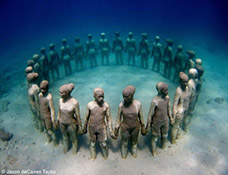![]()
![]()
![]()
![]()
![]()
![]()
 Jason deCaires Taylor is an eco-sculptor who creates life-sized underwater living sculptures. Born in 1974 to an English father and Guyanese mother, Jason deCaires Taylor grew up in Europe and Asia, where he spent much of his early childhood exploring the coral reefs of Malaysia. Educated in the South East of England, Taylor graduated from the London Institute of Arts in 1998 with a BA honors in Sculpture and went on to become a fully qualified diving instructor and underwater naturalist.
Jason deCaires Taylor is an eco-sculptor who creates life-sized underwater living sculptures. Born in 1974 to an English father and Guyanese mother, Jason deCaires Taylor grew up in Europe and Asia, where he spent much of his early childhood exploring the coral reefs of Malaysia. Educated in the South East of England, Taylor graduated from the London Institute of Arts in 1998 with a BA honors in Sculpture and went on to become a fully qualified diving instructor and underwater naturalist.
In 2006, Taylor founded and created the world’s first underwater sculpture park. Situated off the coast of Grenada in the West Indies it is now listed as one of the Top 25 Wonders of the World by National Geographic. His latest creation is MUSA (Museo Subacuatico de Arte), a monumental museum with a collection of over 486 of his sculptural works, submerged off the coast of Cancun, Mexico; described by Forbes as one of the world’s most unique travel destinations. Both these ambitious, permanent public works have a practical, functional aspect, facilitating positive interactions between people and fragile underwater habitats while at the same relieving pressure on natural resources.
Taylor’s art is like no other, a paradox of creation, constructed to be assimilated by the ocean and transformed from inert objects into living breathing coral reefs, portraying human intervention as both positive and life-encouraging. Taylor’s sculptures change over time with the effects of their environment. These factors create a living aspect to the works, which would be impossible to reproduce artificially. As time passes and the works develop biological growth, they redefine the underwater landscape, evolving within the narrative of nature.
Grenada
A few miles north of Grenada’s capital, St. George’s, a 65-piece sculpture garden sits on the ocean floor. Taylor created the Moliniere Bay underwater sculpture garden to help restore the bay’s ecosystem a few years after Hurricane Ivan wiped it out in 2004. And it worked. 16 female forms lie across an extensive sandy area within the reef. Exposed to the will of the seas this is a dynamic and evolving sculpture. At times the figures are hidden and at times they are uncovered and indeed rediscovered. The sculptures lie at a depth of 4 meters and are cast in concrete from a Grenadian lady, reflecting her elegant form. Pink encrusting sponges now cover the face of a life-sized male statue.
His art installation, Vicissitudes, is located 5 meters below the water surface, off the coast of Grenada and consists of 26 life sized human figures. The sculpture demonstrates growth, unpredictability, and transformation. The symbolism of children and the creation of a favorable environment for endangered coral reefs, demonstrates the importance of managing our global ecologies for future generations. The title, vicissitudes, describes the constant state of flux the installation is in, as are our lives and landscapes.
Musa in Cancun Mexico
The Underwater Art Museum (Museo Subaquatico de Arte (MUSA)). is a project created to revitalize and protect four different reefs areas in Cancun and Isla Mujeres, main tourist destinations in the Mexican Caribbean, that attract more than 750,000 divers and snorkelers each year. The project consists in submerging 403 life-size statues that will create in the barren sea bed, new coral reefs thriving with marine life.
Taylor’s sculpture, The Silent Evolution (2010), forms a permanent monumental artificial reef in Mexico. Occupying an area of over 420 square meters and with a total weight of over 200 tons, it consists of 400 life-size casts of individuals taken from a broad cross section of humanity and has been designed to aggregate fish and corals on a grand scale. Slowly but surely these sculptures are evolving, a fur of algae on a girl’s cheek, a starfish on a nun’s face, The Silent Evolution reveals the imperceptible changes of nature on human artifice. Eventually this underwater society will be totally assimilated by marine life, transformed to another state—a challenging metaphor for the future of our own species.
All sculptures have been designed by Mr. DeCaires, and will be made with concrete and other materials that promote coral colonization. By the time the project is completed, these areas will not only benefit from the creation of new coral reefs, but will also be able to offer new opportunities for tourism and cultural events. These underwater museums facilitate the spawning of new coral reefs while freeing-up the surrounding ecosystem from the effects of pollution, tourism and overfishing – important because scientists predict that the ocean’s natural coral landscape will be extinct by 2050 unless measures are taken to reverse the current destruction rate.






